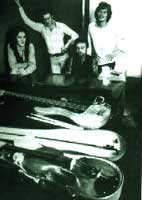Del FAQ de
Elephant
Talk:
Where does the phrase 'Starless and Bible Black' come from?
David Cross, quoted from a Circus-Raves article from 1974,
states,
"The title is a phrase from Dylan Thomas, from 'Under
Milkwood'. . . we have two songs called 'Starless and Bible
Black'. . .The one on the album (S&BB) is a long
instrumental. . .but the idea for a song was still very much
alive in our lyricist, Richard Palmer-James. . .so he came
up with something quite exciting, which is a different 'Starless'
with lyrics."
Here is the Thomas quote:
"To begin at the beginning:
"It is Spring, moonless night in the small town, starless
and bible-black, the cobblestreets silent and the hunched,
courters'-and-rabbits' wood limping invisible down to the
sloeblack, slow, black, crowblack, fishingboat-bobbing sea."
Also note the phrase "Acknowledgement to D. T." on the cover
of LTiA.
What was the phrase Bill Bruford liked to use in place of of
'Starless and Bible Black'?
"Braless and Slightly Slack," apparently a reference to a
memorable audience member.
What does "this night wounds time" refer to? [New Jan. 3,
1999]
Tom Phillips, the cover artwork artist for 'Starless and
Bible Black', created this word-canvas for the gatefold
sleeve. Philips also created the cover art for Brian Eno's 'Another
Green World'.
One of Philip's most intriguing techniques was to use the
Victorian novel 'A Human Document' as a canvas, painting
over selected portions of the printed page in order to
exhibit only sentence fragments. "This night wounds time",
therefore, is the result of taking several random words from
four different lines of text, as the illustration in 'Starless
and Bible Black' shows.
What are the 'The Night Watch' song lyrics about? [New June
25, 2000]
In an interview in the David Cross newsletter, lyricist
Richard Palmer-James responded to this question about the
song that appears on the album 'Starless and Bible Black':
"Nobody understood the song at all when it appeared. But
there's nothing mysterious about it, it's just a brief
historical commentary on Rembrandt and his situation in
17th-century Holland. This is probably not an ideal subject
for rock music. More people seem to realize what the song's
about nowadays. Rembrandt's supreme genius has enriched my
existence since schooldays."
Perhaps seeing the painting itself will help us all to
understand....It's available for viewing at http://www.artchive.com/artchive/R/rembrandt/night_watch.jpg.html.
Also, the full text of the Richard Palmer-James interview is
at http://www.elephant-talk.com/intervws/rpj-ca.htm.
[last update:]
ETer Michael Russell also provides this analysis:
"The topic of the song is Rembrandt's 1642 painting Captain
Frans Benning Cocq Mustering His Company, a canvas
colloquially known as The Night Watch. For almost 80 years
starting in 1566, the Dutch fought for independence from
Spain. After decades of sporadic warfare and truces, lasting
peace was secured as part of the general settlement reached
at Westphalia in 1648. The lyrics to the Crim song are
filled with references to 17th Century Dutch bourgeois life
and experience, including the Spanish conflict."

